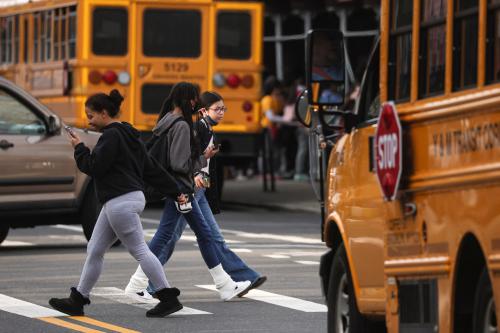School buses are critical, though underappreciated, components of our school infrastructure. Nationally, over half of the nation’s 49.5 million K-12 students use the school bus to get to school each day, at an average cost of about $1,000 per pupil. While people may think of school buses simply as a way to transport students to and from school, this understates their role in U.S. schools and society. School buses facilitate reforms, such as desegregation and district consolidation, and enable students to access better-matched schools than their neighborhood zoned school.
Yet there are also a broad range of concerns about school buses, including reliability, timing, and safety (i.e., no seat belts). One of the most common complaints is that bus rides are too long, with some news stories citing cases where students are on the bus for 4-5 hours each day. These long bus rides could equate to early morning pick-up times and less sleep, late afternoon drop-off times with less time for homework and other activities, or high absenteeism if students find long rides to be unpleasant. In other words, school buses do more than just help students get to school. They could affect academic outcomes like test scores and attendance, too.
Despite the ubiquity of the school bus, we know very little about the commutes of bus riders, the characteristics of students with long bus rides, or whether long bus rides are, in fact, harmful to student outcomes. In a recent study, we address these questions using data from New York City (NYC) to explore the morning commutes of over 120,000 bus riders in grades 3-6 over the period from 2011-2017. We use detailed data on pupil transportation including information on student school bus assignment and morning bus pick-up time.
What do bus rides look like in NYC?
For this study, we focus on students in grades 3-6 who are eligible for bus service. Eligibility is based on criteria such as students’ commuting distance to school and school principals’ decisions to provide buses (versus full-fare MetroCards). Among bus-eligible students, the average ride to school is short—slightly over 20 minutes—and over 75 percent of bus riders have commutes that are less than 30 minutes. Very long bus rides of an hour or longer are quite uncommon.
Commute times do, however, vary considerably between students who attend their zoned school versus those who attend district choice or charter schools. Students who attend a zoned school have an average bus ride of about 13 minutes, while students who attend charter schools or district-run schools other than their own zoned school have commutes that are nearly twice as long at around 25 minutes. This makes sense because students who attend district choice or charter schools tend to live farther away from their school.
The types of students who experience long (45-60 minute) or very long (60+ minute) bus rides is not random. In particular, students with bus rides over 45 minutes are disproportionately more likely be Black and less likely to be white (Figure 1). For example, 47 percent of students with commutes over 60 minutes are Black and only 11 percent are white, while 27 percent of all bus riders are Black and 24 percent are white. This pattern persists even when we compare the characteristics of bus riders who attend the same school or are on the same bus route—students with long bus rides are disproportionately Black.
What is the impact of long bus rides on academic outcomes?
This question is more complicated than it might appear on the surface. The biggest challenge for determining the impact of long bus rides on student performance is that where students live and go to school are not random. For example, more motivated students may be willing to travel longer to attend a better-matched school. If we do not account for this in our analysis, it may appear that long bus rides are better for student performance than they are because more-motivated students will be more likely to have both long bus rides and high academic outcomes. (Conversely, students facing local hardships such as a low-quality zoned school or high-poverty neighborhood may be willing to travel longer to attend a better school.)
To address this challenge, we compare the outcomes of students on the same bus route. These students should live in roughly the same neighborhoods (due to restrictions on route length) and have chosen to attend the same school, but due to idiosyncrasies in bus routing, such as order of pick-up, the length of their bus rides differ. Our models also control for various student characteristics as well as outcomes from the previous school year to account for concerns that students with long bus rides tend to be higher or lower performing. Given the differences we find about commute lengths, we separate our results for zoned, district choice, and charter school students.
We find no effects of long or very long bus rides on zoned school students, but deleterious effects on attendance and chronic absenteeism among district choice students. Long or very long bus rides decrease attendance by 0.17-0.28 percentage points – roughly one-third to one-half school days each year – and increase chronic absenteeism by 1 percentage point. Among charter school students, we find some evidence that very long bus rides decrease reading scores but that there are no effects of commute length on attendance or chronic absenteeism.
Overall, these effects do not differ by race/ethnicity or poverty, with the exception of charter school students for whom the negative impacts of very long commutes on reading are concentrated among poor students. This may be of particular concern given that a key motivation for charter schools is to increase educational access and opportunity for low-income students.
What are the implications for school districts?
Taken together, our study offers three key findings:
- First, long bus rides are relatively uncommon, even in traffic-packed NYC.
- Second, the burden of long bus rides is disproportionately borne by Black students.
- Third, academic outcomes – absenteeism or test scores – are worse for students with long rides exercising school choice. This suggests that some of the benefits of choosing a school farther from home may be eroded by very long commutes, and the potential to improve outcomes and equity by improving bus service.
While this study is set in NYC, some of our findings echo prior research on transportation and school access in other school districts. For example, research in other choice-rich districts like Denver, Detroit, New Orleans, Washington, DC, and Chicago has found that most students live relatively close to school and that Black students tend to live further from school and have longer commutes than their peers. If long bus rides have similar negative consequences in these other contexts, then districts may be wise to consider ways to shorten commutes. One way would be to expand or reallocate bus service, either by using more buses or expanding the walk zone so fewer students living close to school get the bus. Another option could be to follow the example of Boston and re-optimize bus routes harnessing technological and computing advances to optimize bus stop locations and improve routing efficiencies. Finally, districts could consider implementing controlled choice policies that provide preferential admissions to students who live within a limited distance, such as the same or adjacent zip codes. Of course, this also highlights the importance of school siting decisions to ensure that all students are able to attend a well-matched school within a reasonable distance from their home.
School buses play a critical role in education and districts should consider the best way to deploy this key, but expensive, resource to best benefit students.
The Brookings Institution is committed to quality, independence, and impact.
We are supported by a diverse array of funders. In line with our values and policies, each Brookings publication represents the sole views of its author(s).










